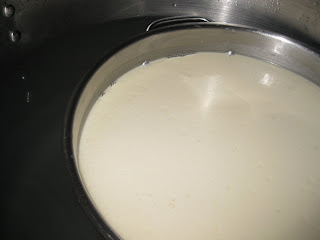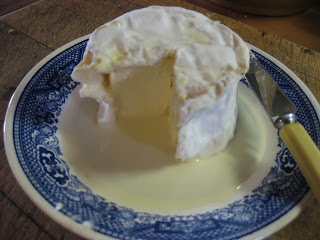
Recently, I have started to make lactic type cheeses as well. The
bloomy rind cheeses fall in this category. Basically, in lactic type cheeses the curd is set by the lactic acid produced by the culture. Depending on various influences, this can take up to as much as 48 hours. Although I do use a small amount of rennet in combination with the lactic acid, it is still considered a lactic type cheese. I usually aim for a 24 hour setting time. The resulting curd is of a grainier texture than rennet set curd due to the higher acidity. Some lactic type cheeses are Chaource, Saint Marcellin, various crottins and a lot of soft goat cheeses.
Rennet type cheeses are set by the addition of rennet to the milk. Because of the usually higher temperature of the milk and larger amount of rennet used, the milk is set within an hour, depending on the type of cheese being made.
The first photograph shows a stockpot with milk floating in a bath of water. Both milk and water are at 72F (22C). The water acts as a warming jacket, preventing the milk to cool off.
In the next picture the curd has set and is pulling away from the wall. This means it is starting to loose whey and is ready for hooping.
Because of the amount of time it takes for the milk to coagulate, fat particles rise to the top. In the third picture, you can see me spooning off the cream. I'll use it as sour cream.
The following two pictures show the hooping process, this is the ladling of the curd into the molds.
The last image shows the draining of the curd. I used two draining trays because I had made two different types of cheese. I did not want the whey to mix to prevent culture exchange. Because of limited space, I stacked the trays.



















































